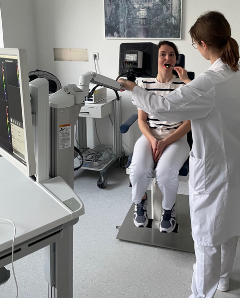Hyperspectral imaging in postoperative perfusion monitoring of intraoral flaps.
 Wausau, WI (February 19, 2024) – Hyperspectral imaging (HSI) provides spectral information about hemoglobin, water, and oxygen supply and thus has great potential in perfusion monitoring. This study explored HSI's feasibility in postoperative monitoring of intraoral free flaps in 14 patients undergoing reconstructive head and neck surgery with radial forearm free flaps.
Wausau, WI (February 19, 2024) – Hyperspectral imaging (HSI) provides spectral information about hemoglobin, water, and oxygen supply and thus has great potential in perfusion monitoring. This study explored HSI's feasibility in postoperative monitoring of intraoral free flaps in 14 patients undergoing reconstructive head and neck surgery with radial forearm free flaps.
The study, led by Veronika Volgger, is titled, “Hyperspectral imaging for monitoring of free flaps of the oral cavity: A feasibility study.” The clinical report, published in Lasers in Surgery and Medicine (LSM), the official journal of the American Society for Laser Medicine and Surgery, Inc. (ASLMS), was selected as the February 2024 Editor’s Choice.
“Malperfusion is the most common reason for flap failure after reconstructive surgery. Until today, perfusion monitoring is highly subjective,” Volgger said. “Within this study, we evaluated if hyperspectral imaging, as an objective diagnostical method, has the potential to assess the postoperative perfusion of intraoral flaps and could thus be beneficial for the patients.”
Flap tissue perfusion was assessed on defined regions of interest by calculating the perfusion indices of Tissue Hemoglobin Index (THI), hemoglobin oxygenation (StO2), Near Infrared Perfusion Index (NIR Perfusion Index), and Tissue Water Index (TWI). This study determined that the use of HSI in the monitoring of intraoral flaps is feasible and might become a valuable addition to the current clinical examination of free flaps. Sufficient exposure and illumination of the area of interest remain challenging and should be considered regarding further technical development.
After graduating from medical school at LMU Munich, Veronika Volgger specialized in Otorhinolaryngology at LMU Munich, where she is currently working as a senior physician. Her main scientific interest is optical diagnostics in the upper aerodigestive tract.
Editor’s Choice is an exclusive article published in LSM, the official journal of ASLMS. View the complete manuscript.
The American Society for Laser Medicine and Surgery, Inc. (ASLMS) is the largest multidisciplinary professional organization dedicated to the development and application of lasers and related technology for health care applications. ASLMS promotes excellence in patient care by advancing biomedical application of lasers and other related technologies worldwide. ASLMS membership includes physicians, surgeons, nurses, and allied health professionals representing multiple specialties, physicists involved in product development, biomedical engineers, biologists, industry representatives and manufacturers. For more information, visit aslms.org.